Doctors for Platelet Disorders Treatment
-

Dr. Debmalya Bhattacharyya
Consultant - Haematology Oncology & BMT Specialist
Unfortunately, there are no hospitals currently offering this treatment. Please check back later for updates.


Department: Haematology
Estimated Cost : $100 - $5000
Platelet Disorders are conditions that affect the number or function of platelets (thrombocytes), which are essential for normal blood clotting. Platelets are tiny, disc-shaped fragments of blood cells that respond to blood vessel injury by clumping together to form a plug that helps stop bleeding. When platelets are too few, too many, or function abnormally, the body cannot form clots effectively, leading to prolonged or spontaneous bleeding.
Platelet disorders may be inherited (genetic) or acquired due to medical conditions, medications, or unknown factors. While some platelet disorders are mild and manageable, others can cause serious bleeding complications and require medical intervention. Diagnosis usually involves blood tests, platelet function studies, and sometimes genetic testing.
Diagnosis of platelet disorders includes:
Treatment varies based on the type and severity of the disorder:
Patients with diagnosed platelet disorders should be monitored regularly and advised to carry medical alert information for emergencies.
@2025 Healtour Solutions Pvt Ltd. All Rights Reserved.